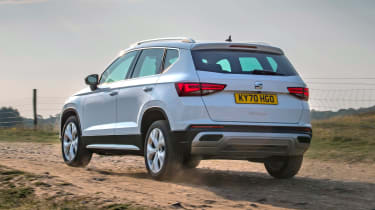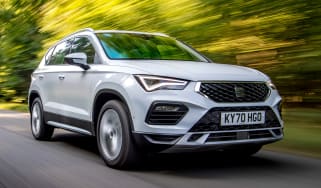SEAT Ateca review – MPG, running costs & CO2
The SEAT Ateca should be cheap to run, and runs class leaders very close
The SEAT Ateca is available with a choice of 1.0-litre and 1.5-litre petrol engines, while until recently a 2.0-litre diesel was also offered. There are no hybrid or plug-in hybrid engines yet, which may limit its appeal to eco-conscious buyers, and push them towards the latest Volkswagen Tiguan with two PHEV options.
SEAT Ateca MPG CO2
The current Ateca range is now petrol-only, which won’t increase your running costs as much as you might expect. Even the most powerful 148bhp 1.5-litre petrol engine is impressively economical, thanks to cylinder-deactivation technology that shuts down part of the engine when full power isn't required. As such, it can return up to 45.6mpg (WLTP-combined) when attached to the six-speed manual gearbox, and only a touch less with the DSG automatic.
The 1.0-litre TSI can return up to 47.0mpg, which makes it the most economical in the current Ateca line-up. It should prove cheap to run, but overall the 1.5-litre is likely to be worth the extra expense for private buyers.
Despite a decent 137g/km CO2 emissions figure for the 1.0-litre TSI model, the Ateca will be a fairly costly proposition for business users, due to the UK’s Benefit-in-Kind (BiK) company-car tax system favouring hybrids and EVs. The plug-in hybrid Volkswagen Tiguan with CO2 emissions of 9g/km will be significantly cheaper to run, even after factoring in its much higher list price.
More reviews
In-depth reviews
Road tests
Now only available used, the least economical petrol engine is the 187bhp 2.0-litre TSI. This is not only because it’s the most powerful but also because it comes with an automatic gearbox and four-wheel drive as standard, so can only manage around 35.3mpg with 182g/km of CO2. These figures aren’t much better than the considerably more powerful Cupra Ateca.
Diesel has been a popular choice for a long time in this segment, and when the Ateca launched it had 1.6 and 2.0-litre variants. Both have been discontinued, although you can expect to find low-mileage examples in showrooms, and it’s still worth a look if pulling power and good economy is a consideration. All the diesel engines use AdBlue to reduce tailpipe emissions, which may need to be topped up between services.
The 148bhp 2.0-litre diesel returns almost the same fuel economy and CO2 numbers as the 1.6-litre 113bhp version, officially managing up to 58.9mpg with emissions starting at 127g/km. Although if you take advantage of the extra power you’ll inevitably burn more fuel. Choose the DSG automatic and four-wheel drive, and consumption drops to 56.5mpg according to the official stats.
Insurance groups
The SEAT Ateca should be reasonably cheap to insure. The 1.0-litre car, available in SE and SE Technology trims, falls into group 10, while all the 1.5-litre petrol models are in groups 18 and 19 – the latter in FR Sport, FR Black Edition and Xperience Lux trim lines.
Warranty
The SEAT Ateca’s warranty is a fairly standard three-year/60,000-mile affair, like every other model in SEAT’s range. That equals the cover Nissan provides for the Qashqai, but it can’t match the five years of the Hyundai Tucson and seven years of the Kia Sportage. You can pay to extend it if you wish, with a four-year or 75,000-mile warranty costing just over £300 and extending cover to five years or 90,000 miles, setting you back £500.
Servicing
SEAT offers a fixed-price servicing plan for the Ateca, covering you for the first two years (or 20,000 miles) for an upfront payment of £480. Alternatively, you can pay £20 per month for 24 months if you want to spread the cost.













